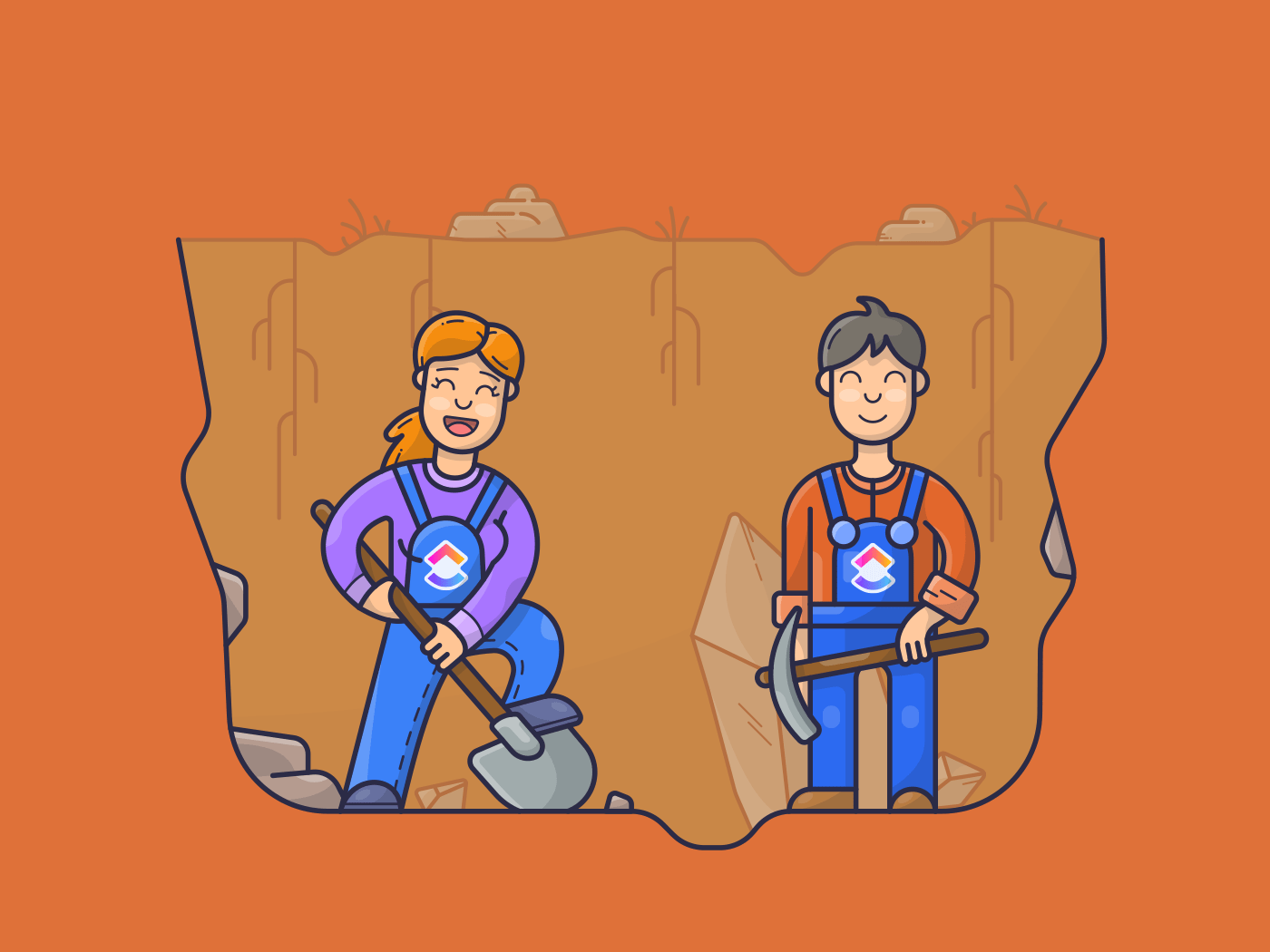سؤال مثير للتفكير لك: كم من يوم عملك تستهلكه رسائل البريد الإلكتروني والاجتماعات والمشتتات المزعجة من يوم عملك؟ إذا لم تكن فخورًا بإجابتك، فمن المحتمل أنه لم يتبق لديك مساحة كبيرة للعمل العميق والمركّز.
إن عدم القدرة على القيام بعمل عميق يمكن أن يؤثر على إنتاجك ويعيق نموك الوظيفي، سواء كنت تعمل من المكتب أو من المنزل. ولكن في ظل جاذبية تعدد المهام أو ثقافة "_العمل المزدحم/المشغول" في الأوساط السائدة، غالبًا ما يتعرض المرء للخطر في الحفاظ على التركيز.
خذ بعين الاعتبار حالة كال نيوبورت وهو مؤلف الكتاب الأكثر مبيعاً العمل العميق: قواعد للنجاح المركّز في عالم مشتت الانتباه . بينما كان العديد من العمال يكدحون في عطلات نهاية الأسبوع، حصل على درجة الدكتوراه من معهد ماساتشوستس للتكنولوجيا ونشر أربعة كتب والعديد من الأوراق الأكاديمية، كل ذلك بينما كان يغادر العمل بحلول الساعة 5:30 مساءً.
وبموازنة ذلك مع دوره كأستاذ علوم الكمبيوتر في جامعة جورج تاون وزوج وأب لثلاثة أطفال، فإن قصته بمثابة شهادة على قوة العمل العميق.
من الواضح أن نيوبورت يعمل على شيء يمكن أن يغيّر الطريقة التي نتعامل بها مع عملنا وحياتنا الشخصية. في هذا المقال، سنناقش 10 عادات صحية يجب أن نتبناها لتجاوز التشتتات واحتضان حقبة جديدة من التركيز والإنتاجية. 🌻
ما هو العمل العميق، وكيف يؤثر على الإنتاجية؟
بإعادة النظر في دراسات نيوبورت، فإن نظريته تدعو إلى أن الإنتاجية الحقيقية تتحقق من خلال الانفصال عن جميع أدوات التواصل والتركيز على العمل المتواصل لفترات طويلة يوميًا - وهذا هو العمل العميق بالنسبة لك.
على الرغم من أنك قد لا تستطيع تجنب التواصل الجماعي تمامًا (على سبيل المثال، رسائل البريد الإلكتروني أو الاجتماعات) من الناحية العملية، إلا أن الهدف هو السعي إلى جلسات عمل متواصلة خالية من التشتت تستمر من 60 إلى 90 دقيقة في كل مرة.
في المقابل, تشير نيوبورت إلى إلى العملالضحل على أنه مهام غير متطلبة معرفيًا ويمكن التعامل معها بطريقة مشتتة. هذه الأنشطة، التي تتميز بطبيعتها اللوجستية والروتينية، تخلق "الإرهاق" دون بذل الكثير من الجهد ويمكن تكرارها بسهولة.
واليوم، لم يعد تحقيق التميز متوقفًا على الجهود السطحية والسطحية. ولكي يحافظ الأفراد على قدرتهم على المنافسة وبناء ملف مهني أو إبداعي مؤثر، يجب عليهم استيعاب المفاهيم المعقدة بسرعة وتطبيق معارفهم لإنتاج عمل استثنائي.
لحسن الحظ، فإن فعالية العمل العميق وقدرته على دفعك إلى الأمام في المدرسة أو الحياة المهنية مدعومة بالعلم. يتطلب هذا النوع من العمل حضورًا معرفيًا عاليًا، وهو ما يبني مسارات عصبية في دماغك، مما يجعلك أكثر قدرة على التعامل مع المهام المعقدة التي تنطوي على التفكير النقدي وحل المشكلات بمرور الوقت.
4 فوائد تغير حياتك للعمل المتعمق في حياتك المهنية والشخصية
يعد العمل العميق نهجًا فعالاً للغاية لعدة أسباب مقنعة - دعنا نتعمق أكثر في ذلك:
- السيطرة على المشتتات التي لا هوادة فيها: تشير الدراسات إلى إلى أن الأمر قد يتطلب أكثر من 20 دقيقة لاستعادة تركيزك وزخمك الكاملين بعد الانقطاع. إن العمل العميق مفيد في مساعدتك على التخلص أو التقليل من التحويلات الخارجية مثل وسائل التواصل الاجتماعي ورسائل البريد الإلكتروني والاستهلاك العشوائي للترفيه. نظرًا لأنك تنغمس تمامًا في مهمة العمل العميق التي بين يديك، تتحسن إنتاجية وجودة عملك
- زيادة الإقبال على المهام المعقدة: من خلال الممارسة المستمرة، يقوي العمل العميق قدرة دماغك على التعامل مع الموضوعات الصعبة وسير العمل المعقد. ونتيجة لذلك، تكون مجهزًا بشكل أفضل لتعلم مهارات جديدة ومعالجة المعلومات وإنتاج أعمال متميزةعمل أسرع
- مخرجات عالية القيمة: امتدادًا للفائدة السابقة، يساعدك العمل العميق على إعطاء مهامك مائة بالمائة مما يؤدي إلى مخرجات عالية المردود. لنفترض أنك ركزت لمدة خمس ساعات متواصلة لتخرج بمخرجات عالية القيمةاستراتيجية مبيعات قوية. تخيل الآن القيام بالمهمة نفسها في فترة 12 ساعة معطلة بسبب الاتصالات أو العمل الإداري - قد لا يكون ناتجك جيدًا لأن عقلك سيكون مشبعًا أو محفزًا للغاية بحيث لا يستطيع التفكير
- تحسين احترام الذات والانضباط: يؤدي تضييع الوقت في العمل السطحي، وخاصةً المشتتات، إلى إحداث تأثير الدومينو. فأنت تشعر بالفساد حيال فقدان الأهداف والفشل في اكتساب الزخم في الحياة. أما العمل العميق، من ناحية أخرى، فيضعك على طريق الإنجاز، والذييحسن صحتك النفسية وينعش روحك المعنوية ## كيفية تطوير روتين عمل عميق: 10 تقنيات تحقق النتائج
لقد أصبح العمل العميق مهارة يصعب اكتسابها بسبب حياتنا الرقمية للغاية. من الصعب أن نتحرر من ثرثرة الهواتف الذكية ورسائل البريد الإلكتروني والإشعارات، مما يؤدي بنا إلى أن نكون في عالم مشتت طوال الوقت، إلى الحد الذي يستنزفنا حتى في القليل من العمل المعرفي.
كما يؤكد كال نيوبورت "إن القدرة على أداء العمل العميق أصبحت نادرة بشكل متزايد في نفس الوقت الذي تزداد فيه قيمتها في اقتصادنا. ونتيجة لذلك، فإن القلة الذين ينمون هذه المهارة ويجعلونها جوهر حياتهم العملية سوف يزدهرون
إذن، كيف يمكننا تنمية هذه المهارة الحياتية الرئيسية؟ ثلاث طرق:
- اتباع أفضل ممارسات العمل العميق بإخلاص: لا يمكنك أن تختصر الطريق هنا - هناك العديد من التقنيات الراسخة (التي نناقشها أدناه) التي تساعد على بث سحر العمل العميق في حياتك اليومية، ويجب أن تبذل جهدًا واعٍ لاتباعها
- ابحث عن أداة إنتاجية رقمية: يمكنك محاربة المشتتات الرقمية باستخدام تطبيقات الإنتاجية (مثلClickUp). تحتوي هذه التطبيقات على حلول مدمجة مثل تتبع الوقت والمهام للتركيز الخالي من التشتت
- تحلى بالصبر: لن تتطور شهيتك للعمل العميق في يوم أو أسبوع. احترم كيفية عمل الدماغ البشري، وحافظ على اتساقك مع ممارساتك، واسمح لتلك المسارات العصبية أن تصبح أقوى تدريجيًا
والآن، دعنا نلقي نظرة على 10 طرق ذهبية لتبدأ مهمة العمل العميق! 😊
1. تحديد أولويات المهام
وجدت دراسة أجرتها هارفارد بيزنس ريفيو أن العامل العادي يهدر ما يصل إلى 41% من ساعات العمل على مهام منخفضة القيمة، مما يفشل في تخصيص وقت للعمل المهم.
إن تعلّم ترتيب الأولويات هو العمل العميق 101، سواء كنت تعمل بمفردك أو مع فريق. وتتمثل الفلسفة في أن تعدد المهام له عوائد متناقصة قد تؤدي إلى مخرجات منخفضة التأثير. لبدء العمل العميق، تحتاج إلى:
- التعرف على المهام عالية التأثير على مدار اليوم
- تحديد أولويات تلك المهام
- تفويض المهام ذات القيمة المنخفضة أو تأجيلها
يضمن تحديد الأولويات أن تكون جلسة العمل العميقة مركزة على ما هو مهم حقًا - و يمكنك القيام بذلك بسهولة مع ClickUp!
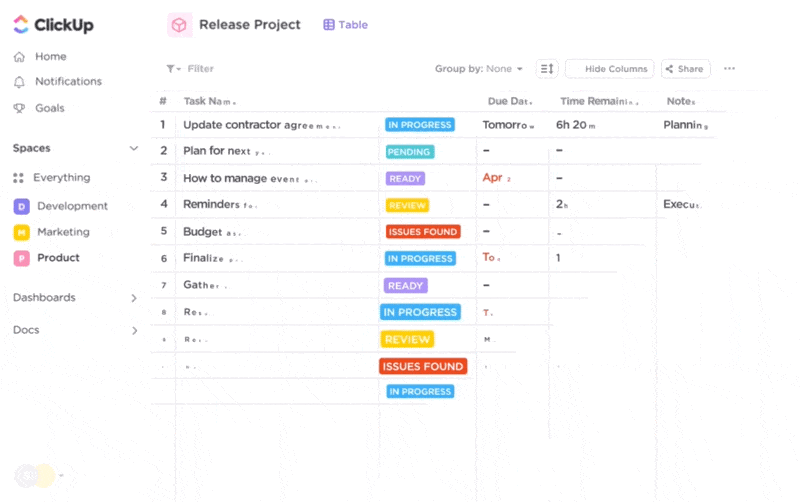
حسِّن وقتك ومواردك للعمل العميق باستخدام قالب ClickUp للمخطط الأسبوعي
كمنصة شاملة لإدارة العمل، يقوم ClickUp بإعدادك بأربع علامات مرمزة بالألوان عاجل، عالي، عادي، منخفض لإبراز الأولويات في قائمة مهامك . فهي توفر توجيهات واضحة تمامًا، مما يضمن لك ولفريقك معرفة ما يجب القيام به ومتى. من خلال إسقاط العناصر ذات الأولوية العالية في قائمة مهامك التي تحوم حول علبة المهام يمكنك الاحتفاظ بها على الدوام، لتكون بمثابة الدليل المثالي ليومك.
يذهب ClickUp إلى أبعد من ذلك، حيث يقدم أكثر من أكثر من 35 تطبيق نقر لتخصيص إدارة المهام لأي حاجة عمل. من المهمة الأتمتة للتعامل مع المهام الإدارية الشاقة لـ الحقول المخصصة لتتبع البيانات، فهي تمكّنك من صياغة بيئة حاضنة للعمل العميق. 🌱
2. إنشاء طقوس شخصية
لدى الكثير منا طقوس شخصية، مثل فنجان القهوة الصباحي، لبدء اليوم. ولكن ماذا عن الطقوس الشخصية للعمل العميق؟ هذه طقوس روتينية فريدة مصممة لتحسين تركيزك وإنتاجيتك. قد تتضمن ضبط إضاءة محيطة محددة، أو الاستماع إلى موسيقى مؤرضة، أو حتى تمرين قصير للذهن قبل الخوض في العمل العميق. 🧘
الأمر متروك لك في كيفية إدارة يومك، ولكن بشكل عام، يمكن تخصيص فترة الصباح للعمل العميق حيث يكون دماغك أكثر تقبلاً للمتطلبات المعرفية، بينما يمكن تخصيص فترة ما بعد الظهر للاجتماعات والمهام الخفيفة. ربما تعمل بشكل أفضل مع فترات استراحة منتظمة أو تزدهر في جلسات أطول دون انقطاع. في كلتا الحالتين، حدد ما يناسبك وقم ببناء طقوسك.
إن قالب المخطط الأسبوعي ClickUp هو أداة تمكين رائعة إذا كنت قد بدأت للتو في العمل العميق. تسمح لك واجهته المرئية بتحسين أسبوعك للمهام ذات الأولوية والاجتماعات والالتزامات الشخصية والاستراحات حتى تتمكن من ترسيخ طقوسك من خلال الاتساق.

حسِّن وقتك ومواردك من أجل العمل العميق باستخدام قالب مخطط ClickUp الأسبوعي
3. جدولة العمل العميق
يتطلب وضع جدول زمني واقعي مشبع بطقوس العمل العميق تخطيطًا دقيقًا. لن تنجح خربشة الملاحظات - يجب أن تتعلم كيفية تنظيم المهام اليومية في التقويم بكفاءة و استخدام حظر الوقت لحجز خانات للعمل العميق. يتعلق الأمر كله بتخصيص فترات زمنية غير متقطعة للمهام المهمة، وهو ما يسلب منك أو من فريقك قوة الاختيار ويضبط العقل المهيأ للوقوع في الملهيات.
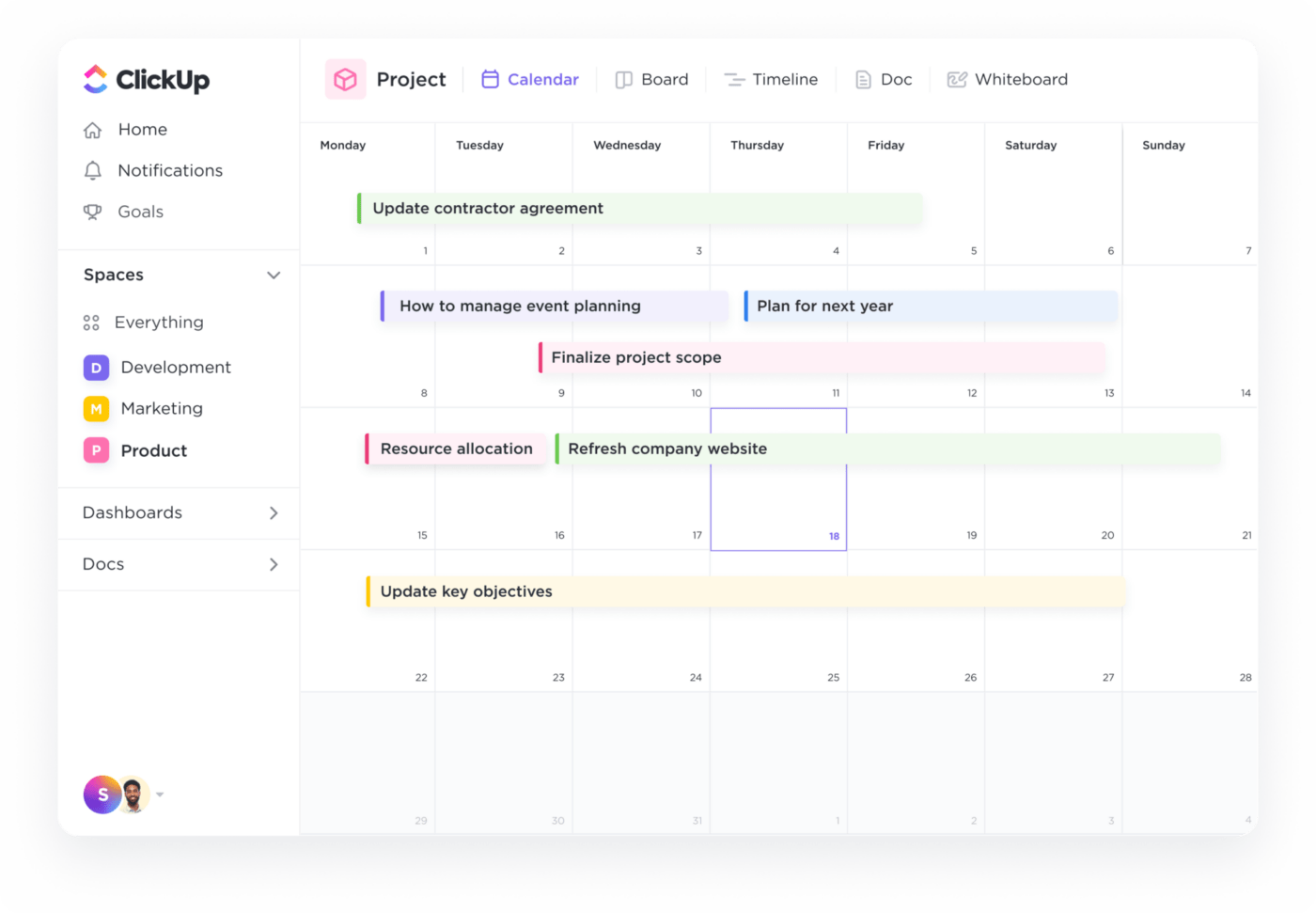
تسجيل وتتبع الوقت المستغرق في المهام والمشروعات بدقة في ClickUp عرض تقويم ClickUp يجعل هذه العملية سلسة وفعالة. بواسطة حجب الفترات الزمنية المخصصة للمهام الإدراكية، يمكنك تثبيت الأجزاء غير القابلة للتفاوض من يومك وتحقيق أهداف الإنتاجية مع الحفاظ على توازن صحي بين العمل والحياة. هل تحتاج إلى مساعدة في الجدولة؟ لديك مجموعة مختارة من قوالب حظر الوقت للاختيار من بينها!
مع تقويم ClickUp القابل للتخصيص، يمكنك صياغة جدول زمني يتماشى مع إيقاعك اليومي، مما يضمن لك المزامنة الدائمة للمهام. تشمل مزايا الجدولة الأخرى ما يلي:
- تقديرات الوقت للتنبؤ بأوقات التسليم
- الحالات المخصصة لتتبع تقدم المهمة
- التبعيات والعلاقات لجدولة مهام الفريق بترتيب منطقي
- علامات المهام لتحسين رؤية عناصر العمل وإمكانية الوصول إليها
4. تتبع كيف تقضي وقتك
الوقت هو العملة الأكثر قيمة بالنسبة لك، وسيساعدك الفهم الشامل لتخصيصه على تحديد أولوياتك و التركيز على المهام عالية المردود . ابدأ بتدوين كيف تقضي كل ساعة أو الجهد المطلوب للمهام. وسرعان ما ستظهر الأنماط التي تسلط الضوء على ساعات تركيزك الأكثر عمقًا والأوقات التي تميل فيها إلى الاسترخاء. استخدم هذه البيانات لإعادة هيكلة يومك وتخصيص وقت للعمل العميق خلال أوقات ذروة الإنتاجية. ⏳ تتبع وقت المشروع في ClickUp يمكن أن تكون هذه الميزة مساعدك البارع هنا. فهي تتيح لك تسجيل ساعات عملك، وتعيين تقديرات الوقت، وتدوين الملاحظات المهمة، بل واستحضار جداول زمنية وتقارير مفصلة، بغض النظر عن مكان وجودك.
![]()
سجل وتتبع بدقة ساعات العمل العميقة التي تقضيها في المشاريع في ClickUp بدقة
مع تطبيق ClickUp المجاني أو امتداد كروم ، يمكنك تسجيل وقتك من سطح المكتب أو الهاتف المحمول أو متصفح الويب - كل ذلك متزامن بشكل مثالي. لا تساعدك هذه الميزة على تتبع تقدمك فحسب، بل تساعدك أيضًا على ضبط إدارة وقتك أو استراتيجيات تحسين العملية .
5. الحد من تبديل السياق تبديل السياق يشير إلى التعامل مع التدفق المستمر للمهام والرسائل ورسائل البريد الإلكتروني غير ذات الصلة على مدار اليوم. إنه قاتل سيئ السمعة للإنتاجية، حيث يؤثر سلبًا على الأداء المعرفي للعامل وحتى
خفض معدل ذكائهم . ويزداد الوضع سوءًا إذا اضطررت إلى التنقل بين التطبيقات المختلفة للتعامل مع تلك المهام - فهي تبطئك وتضعف أداء جهازك.🪫
الحل؟ احرص على إكمال مهمة واحدة بتركيز عميق قبل الانتقال إلى المهمة التالية - كتم صوت Slack، أو التواصل غير المتزامن، أو استخدام إشعارات مخصصة. إذا كان الانقطاع أمرًا لا مفر منه، لاحظ أين توقفت لجعل الانتقال أكثر سلاسة.
بصفتك نقطة توقف واحدة حل إدارة المهام والمشاريع ، فإن ClickUp هو حليفك الاستراتيجي في المعركة ضد تبديل السياق، مما يساعدك على الاحتفاظ التركيز على العمل العميق . بدلًا من التنقل بين تطبيقات متعددة، يمكنك إدارة سير عملك بالكامل على هذه المنصة.
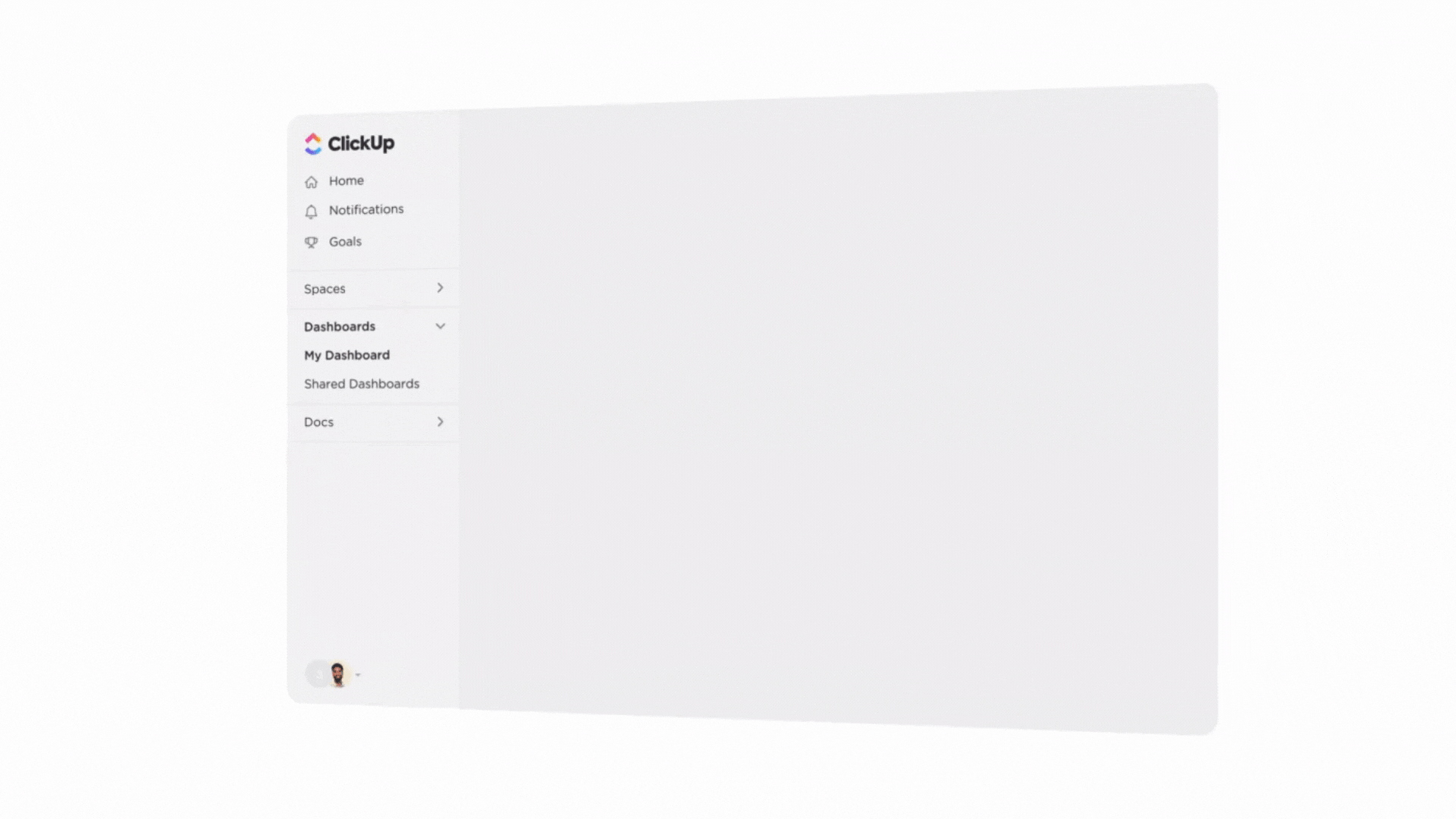
يجمع ClickUp فرقك معًا لتخطيط وتتبع والتعاون في أي مشروع - كل ذلك في مكان واحد إنشاء طرق عرض خاصة داخل ClickUp لتصميم عروض مهام مخصصة حصريًا لعينيك. وبفضل خيار تجميع المهام وفرزها وتصنيفها وتصفيتها وإعداد إشعارات مخصصة، يمكنك تقليل التعطيل الناجم عن التبديل المستمر بين السياقات. بالإضافة إلى ذلك، توفر المنصة الشريط الجانبي للمفضلة مع إمكانية الوصول بنقرة واحدة، مما يتيح لك وضع إشارة مرجعية لمواقع مساحة العمل التي تزورها بشكل متكرر.
بالنسبة لأولئك الذين يتعاملون مع تطبيقات متعددة، يوفر ClickUp عمليات تكامل أصلية ومخصصة لتركيز عملك وتقليل وقت التخزين المؤقت. تواصل مع أكثر من 1,000 تطبيق بما في ذلك البريد الإلكتروني، والاجتماعات، وأدوات التسويق، دون كتابة تعليمات برمجية!
6. استخدام تقنيات الإنتاجية
تخيّل تقنيات الإنتاجية كصندوق أدواتك الشخصية للتغلب على المماطلة وتعظيم إمكانات عملك العميقة. 🧰
إليك بعض التقنيات الشائعة على نطاق واسع لاستكشافها:
- مؤقت بومودورو : اعمل لمدة 25 دقيقة، ثم خذ استراحة لمدة 5 دقائق لتحقيق النجاح المركز. إنها طريقة بسيطة لكنها فعالة للحفاظ على التركيز وتجنب الإرهاق. فترات عمل بومودورو المتطورة المدعومة بالذكاء الاصطناعي من ClickUp يمكن أن تساعدك في الحفاظ على تركيزك وإنجاز المزيد في جلسات عمل أقصر
- صندوق أيزنهاور : استخدم هذامخطط المصفوفة لتحديد أولويات المهام بناءً على مدى إلحاحها وأهميتها
- نظام إنجاز المهام (GTD) نظام إنه طريقة لتنظيم وإدارة المهام والمشاريع والمعلومات بطريقة تقلل من الفوضى الذهنية ويعزز الإنتاجية. إليكدليل مفصل لإتقان منهجية GTD
- طريقة كانبان: تصور عملك على لوحة مع أعمدة لتمثيل المراحل المختلفة للإنجاز
- قاعدة الدقيقتين: إذا استغرق إنجاز مهمة ما أقل من دقيقتين، فقم بإنجازها على الفور. تقلل هذه القاعدة من تراكم المهام الصغيرة وتحرر مساحتك الذهنية
- تناول الضفدع: ابدأ يومك بمعالجة أكثر المهام صعوبة أو أقلها متعة أولاً، أي أكل الضفدع. تضمن لك هذه التقنية عدم المماطلة في الأعمال المهمة

حافظ على تركيز فريقك من خلال إنشاء نظام كانبان مرن لتصور عملك وتحسين إدارة المشروع في ClickUp
هل تحتاج إلى تعزيز؟ يمكنك العثور على العديد من قوالب الإنتاجية على ClickUp - فهي تستند إلى ممارسات الإنتاجية التي تم اختبارها ويمكن أن تساعدك على تنظيم العمليات اليومية للفريق بأكمله.
7. تقليل المشتتات
في عالم مشبع بالإشعارات والمكالمات وتصفح وسائل التواصل الاجتماعي الطائش، فإن المشتتات هي العدو اللدود للعمل العميق. والحل يشبه إلى حد كبير ما تفعله مع تبديل السياق - وضع حدود واضحة لإنشاء منطقة خالية من الإلهاء في العمل.
إن إيقاف تشغيل الإشعارات غير الضرورية، وإنشاء مساحة عمل مخصصة، وتوصيل الحاجة إلى التركيز دون انقطاع هي أسلحتك. لقد وجدنا أيضًا أن جدولة أوقات محددة لتفقد البريد الإلكتروني ووسائل التواصل الاجتماعي تحد من المحفزات الخارجية خلال فترات العمل العميقة.
إذا وجدت نفسك تبحث عن الملهيات باندفاع، فقد ترغب في استكشاف صيام الدوبامين ل "إعادة ضبط" دماغك - يتطلب منك تقييد تعرضك للمحفزات (مثل تفقد تحديثات الحالة على وسائل التواصل الاجتماعي) التي تحفز إنتاج الناقل العصبي الدوبامين، أي المادة الكيميائية التي تبعث على الشعور بالسعادة. وبمرور الوقت، يجب أن ينظم دماغك إنتاج الدوبامين، مما يساعدك على التحكم في الانفعالات. 🧠
8. احتفظ بالمعلومات في متناول يديك
غالبًا ما يتطلب منك العمل العميق إجراء اتصالات والبحث عن حلول مبتكرة بعيدًا عن قيود الاجتماعات المنظمة. وهذا يعني أنك تحتاج إلى أن تكون جميع المعلومات ذات الصلة في متناول يدك، سواء كانت وثائق المشروع أو خطط العمل، حتى لا تضيع الوقت في العثور على ما تحتاج إليه.
ClickUp هي أداة قوية لإدارة المعرفة لتسهيل جلسات العمل العميقة. يمكنك تخزين أي نوع من المعلومات في مستندات ClickUp -كلها يمكن الوصول إليها بسهولة عبر البحث الشامل.
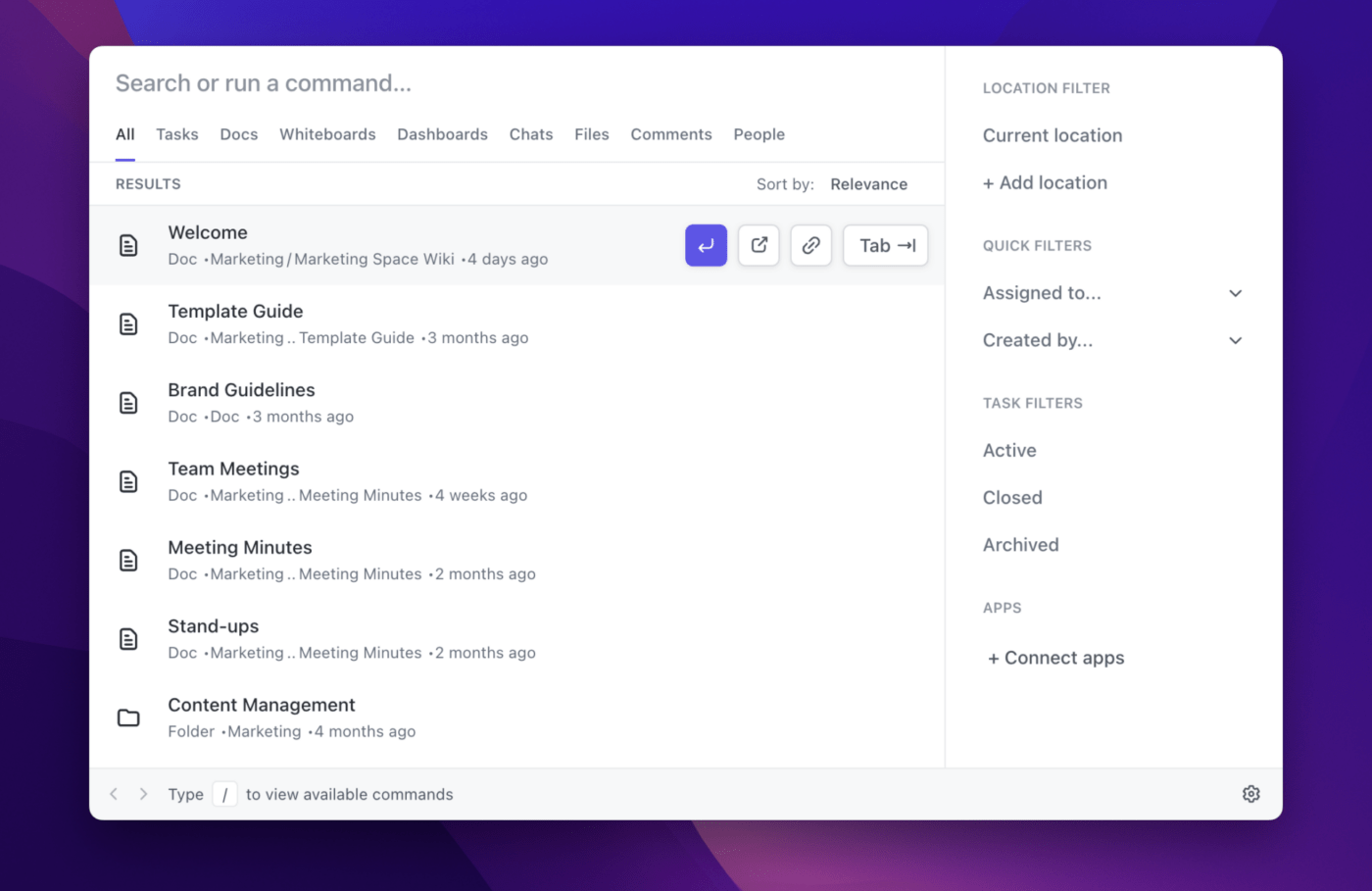
ابحث بسهولة عبر جميع المهام، والمستندات، والمشاريع في ClickUp للانتقال إلى عملك
إذا كنت تعمل على شيء إبداعي أو تحليلي، فإن المنصة تقدم أيضًا اللوحات البيضاء و الخرائط الذهنية لمساعدتك في رسم المفاهيم, تدوين ملاحظات سريعة وصياغة تمثيلات مرئية لأفكارك بسهولة.
9. الحفاظ على الصحة البدنية
صحتك البدنية وإنتاجيتك في العمل مترابطان. أعط الأولوية للأولى لتعزيز الثانية.
وإليك ما يمكنك تجربته لتعزيز اندفاعك للعمل العميق:
- فكر في دمج تمرين قصير في روتينك الصباحي لبدء يومك بصفاء ذهني أكبر
- حافظ على ترطيب جسمك بشكل جيد للحفاظ على وظيفة الدماغ المثلى (لذا أبقِ زجاجة الماء قريبة منك)
- ادمج تمارين التمدد القصيرة أو تمارين التنفس طوال يوم عملك لتجديد نشاط جسمك وعقلك
- خذ فترات راحة قصيرة منتظمة لتجديد مستويات الطاقة لديك
- زوّد جسمك بالأطعمة الصحية واحصل على الراحة التي يحتاجها. لا يتعلق الأمر فقط بالشعور بالراحة بل بتحسين أداء جسمك من أجل تنمية عادة العمل بعمق
10. حدد أهدافك وتتبعها
إن تحديد الأهداف هو أهم ما يميز العمل العميق. لا يكفي أن تتمنى الإنتاجية - بل يجب أن تسعى جاهدًا لتحقيقها من خلال تحديد أهدافك وقياسها بموضوعية.
قبل ممارسة عملك العميق، كن واضحًا بشأن هذه الجوانب الأربعة:
- حدد أهدافك: ما الذي تريد تحقيقه؟ كن دقيقًا قدر الإمكان
- حدد مواعيد نهائية: هذه بمثابة دفعة مطلوبة بشدة للبدء والبقاء على المسار الصحيح
- مراقبة التقدم: كيف ستقيس نجاحك؟ تحقق بانتظام من المسافة التي قطعتها والمسافة التي تحتاج إلى قطعها
- احتفل بالانتصارات: لا تنسى أن تكافئ نفسك على الانتصارات الصغيرة على طول الطريق
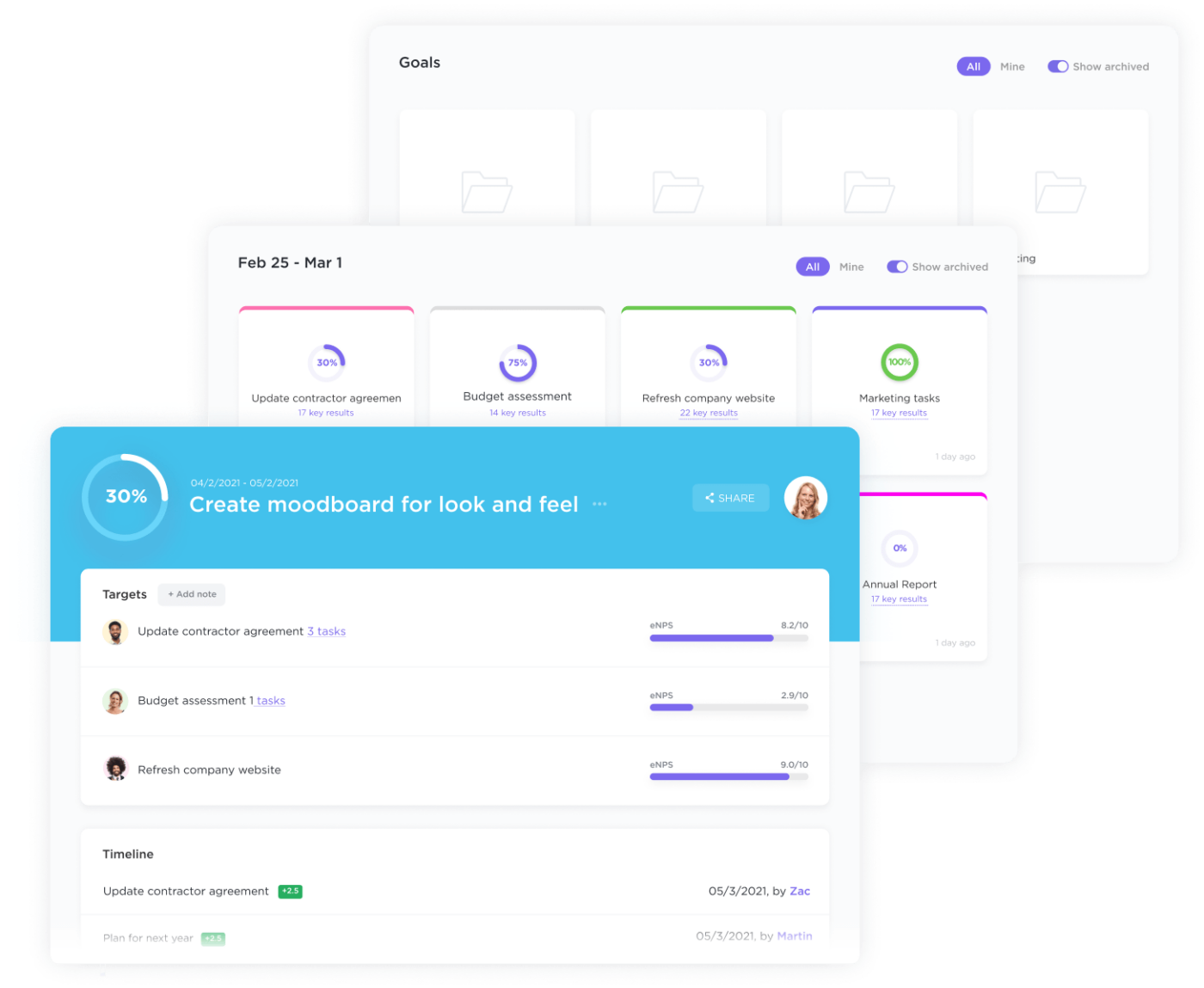
ابقَ على المسار الصحيح لتحقيق أهدافك من خلال جداول زمنية واضحة، وأهداف قابلة للقياس، وتتبع التقدم التلقائي
لحسن الحظ، كل هذا ممكن وفعال بشكل لا يصدق مع أهداف النقر مما يجعل رحلة الإنجاز الشخصي والمهني رحلة سلسة ومجزية. 🏆
يسمح لك بالحفاظ على أهدافك منظمة بدقة داخل مجلدات سهلة الاستخدام. سواء أكان ذلك تتبع دورات العدو, OKRs أو العميقة معالم العمل يمكنك إنشاء مجلدات لضمان أن يكون لكل هدف مساحة مخصصة له.
تنظيم سيمفونية العمل العميق مع ClickUp
إن إتقان العمل العميق يشبه تعلّم العزف على آلة موسيقية - يستغرق وقتاً وصبراً وممارسة. والآن بعد أن حصلت على الأدوات واللحن - حان وقت العزف!
لحسن الحظ، ClickUp هو نوتتك الموسيقية، فهو يبسّط لك نوتات الإنتاجية. بفضل خيارات إدارة المهام والوقت البديهية ، يصبح العمل العميق رحلة لحنية يتناغم فيها جهدك مع أهدافك!
انطلق و اشترك في ClickUp -وأظهر للعالم تحفتك الفنية! 🎼
